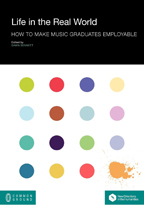 Life in the Real World: How to Make Music Graduates Employable (2012). Edited by Dawn Bennett. Champaign, IL: Common Ground Publishing LLC. 284 pages. ISBN-10: 1612290787
Life in the Real World: How to Make Music Graduates Employable (2012). Edited by Dawn Bennett. Champaign, IL: Common Ground Publishing LLC. 284 pages. ISBN-10: 1612290787
http://www.amazon.com/Life-Real-World-Graduates-Employable/dp/1612290787
Born out of research, practice, and discussions arising from the International Society for Music Education’s (ISME) Commission on the Education of the Professional Musician, Life in the Real World: How to Make Music Graduates Employable offers global perspectives and practical advice for university faculty about skills our graduates need to survive as twenty-first century professional musicians.1 It also includes practical advice for ways in which we can help students hone these skills during their undergraduate years. The book consists of two sections: the first explores actual careers, issues, musical skills, and personal traits necessary for musicians to be successful in today’s world. The second section is comprised of 35 short, descriptive chapters, each of which outlines useful activities, workshops, reflection exercises, and seminars that can be used during undergraduate music study.
The first eight chapters of the book explore the global context in which our graduates will pursue careers in music. While pertinent research from specific countries is discussed in each chapter, and extensive resource lists (both in print and online) are provided, each author teases out practical implications of research findings that may be generalizable. Throughout this section, seven contributors from North America, Europe, and Australia reflect on the state of music employment across the globe. All of the contributors work and conduct research in conservatories and universities; however, they represent diverse perspectives including performance (Janis Weller), composition and music industry (Michael Hannan), musicology (Glenn Carruthers), music education and musical identity (Rosie Perkins and Dawn Bennett), lifelong learning (Rineke Smilde), and entrepreneurship programs (Angela Myles Beeching). The authors remind readers that very few music graduates enjoy elite solo performing careers. Rather, a plethora of skills will need to be utilized in order for twenty-first century musicians to enjoy professional satisfaction and to earn a sustainable income. Research suggests that recent music graduates tend to lead what has become known as “portfolio” or “Protean” careers; Dawn Bennett explains that the term “portfolio” refers to leading “multiple concurrent roles in music,” while “Protean” references the “Greek sea-god, who was able to change form at will in order to avoid danger” (p. 7). To this end, Bennett, Beeching, Perkins, Carruthers and Weller contend that throughout their careers young professionals will need to be adaptable, flexible, and avail themselves of musical and tangentially-related skills; for example, various types of performance abilities, traditional aural skills, improvisatory and compositional skills (which will need to be enhanced by technology), entrepreneurial expertise, marketing and self-promotion strategies, and interpersonal skills, to name but a few, will be required for future musical success.
While the temptation in the first section of the book might be for the reader to focus mainly on the chapter related to the geographical location in which he or she teaches, the value of this section may be in the exploration of roles, identities, career choices, and professional context from a global perspective. The authors remind university educators that the world has become increasingly interconnected, where musicians are both highly mobile and regularly linked with colleagues across the globe. Thus, young professionals will likely enjoy many more opportunities than those that currently exist in the cities, states, and countries in which they are educated.
After making a case for the need to help music students develop critical skills that may not be part of the current undergraduate curriculum, the authors present detailed activities which may help students to discover their identities and future roles as musicians in the second section of the book. Activities for students include questionnaires, quizzes, and matrices that encourage students to conceptualize and articulate their real career goals and passions. Many of the exercises prime students to visualize fulfilling lives that include more than performance. The activities are grouped into three broad categories: “from self to career,” “from career to community,” and “survival skills.” Creative student exercises include conceptualizing a music career, constructing musician profiles, understanding musician lifestyles, expanding necessary skill sets, and transitioning from academy to career. There are activities that can be explored by students in groups during class, as well as assignments that can be completed individually, either inside or outside of the classroom.
Although some schools of music are grappling with curricular reform and implementing entrepreneurship programs, service learning, and interdisciplinary projects that prepare students for professional success, it is likely that many of the activities described in this book could be incorporated into existing classes without having to make major curricular adjustments. To take two examples: a creative group activity is Bennett’s “Turning on the career light,” which is a workshop where students are given boxes that contain diverse objects such as a feather boa, a first aid kit, and a telephone. In small groups they must discover how the items might be related to musical careers and then share these insights with others. Following the workshop students are invited to reflect on multiple identities that may be experienced in their own careers as musicians. Another group activity, “Finding your mission,” contributed by Rosie Perkins, contains four challenges that when undertaken and reflected upon over time should prepare music students to be more flexible throughout their careers.
Life in the Real World is well written, clear, and concise. More importantly, it provides both context and content that educators of musicians can use. This book would be a valuable resource for any college teacher’s library, as a reference manual for useful career and identity-development activities, or as a resource for beginning or continued discussion about curricular considerations within music units.
Notes
1. More information about the ISME Commission for the Education of the Professional Musician can be found at http://www.isme.org/ceprom.


